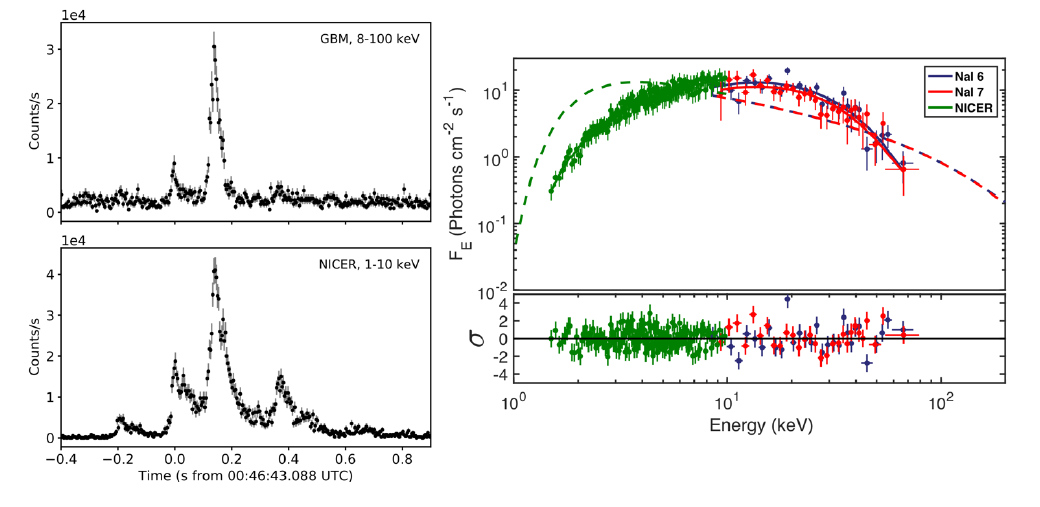NICER / ISS Science Nugget
for November 5, 2020
FR/GR/B
On April 28, 2020, a supermagnetized stellar remnant known as a magnetar blasted out a simultaneous mix of X-ray and radio signals never observed before. The flare-up included the first "fast radio burst" (FRB) ever seen from within our Milky Way galaxy, and shows that magnetars can produce these mysterious and powerful radio blasts previously only seen in other galaxies. NICER played an important role in this discovery and its interpretation, as reported in a NASA press release.
Thanks to ISS infrastructure that affords rapid target-of-opportunity (TOO) follow up, NICER observed the magnetar, SGR 1935+2154, within a few hours of a report of enhanced activity by NASA's Swift observatory. NICER detected roughly 200 X-ray bursts during a 20-min observation window. Thirteen hours later, the Canadian CHIME radio observatory and the Jet Propulsion Laboratory's STARE2 experiment detected a millisecond-duration radio burst, similar to past FRBs, but from the direction of SGR 1935 and with unprecedented brightness. X-ray and gamma-ray observatories detected a burst at the same time; unfortunately, SGR 1935 was inaccessible to NICER at the time of the simultaneous radio/X-ray burst.
This unique result involving NICER and other observatories from around the world demonstrates that magnetars, the strongest magnets in the universe, are responsible for at least some FRBs. NICER's spectroscopic and timing data (see figure) from the SGR 1935 "burst storm" inform a new model for the first Milky Way FRB, involving emission from near the star's magnetic pole, that has been submitted for publication.
 Figure: The left-hand panels show intensity as a function of time for one of 24 bursts observed simultaneously with NICER and the Fermi telescope's Gamma-ray Burst Monitor (GBM) instrument via its sodium-iodide (NaI) detectors, in slightly overlapping photon energy bands. The right-hand panels show their joint energy spectra: points with error bars represent binned count rates, solid curves the model fit to the data (fit residuals appear in the lower panel), and the dashed curve the distinct spectrum of the FRB-associated X-ray burst detected hours later with another telescope. Figure credit: G. Younes et al.
Figure: The left-hand panels show intensity as a function of time for one of 24 bursts observed simultaneously with NICER and the Fermi telescope's Gamma-ray Burst Monitor (GBM) instrument via its sodium-iodide (NaI) detectors, in slightly overlapping photon energy bands. The right-hand panels show their joint energy spectra: points with error bars represent binned count rates, solid curves the model fit to the data (fit residuals appear in the lower panel), and the dashed curve the distinct spectrum of the FRB-associated X-ray burst detected hours later with another telescope. Figure credit: G. Younes et al.
<< Previous
Main Index
Next >>